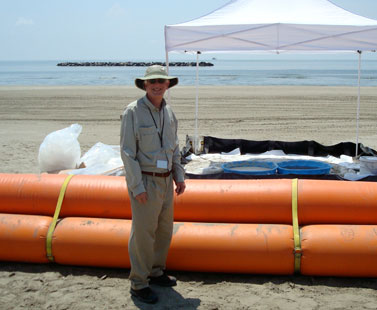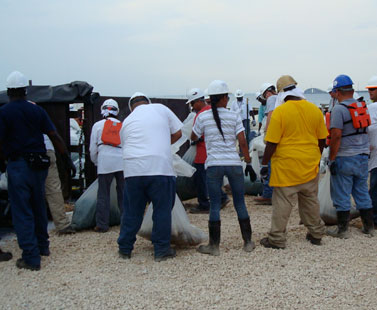Health effects of Gulf Coast heat
USF public health professor assesses measures to protect oil spill cleanup workers from heat illness
The most serious imminent health risk for workers helping with the Deepwater Horizon oil spill cleanup may not be the oil or chemicals dispersants – but the unrelenting Gulf heat.
“It’s was miserably hot and humid,” said Thomas Bernard, PhD, professor and chair of Environmental and Occupational Health at the University of South Florida College of Public Health. “When you have 10,000 people working outdoors in that type of environment, you’re bound to have some heat-related illnesses… Exertional heat stroke is our main acute health concern.”
An expert in heat stress management, Bernard has been tapped to review and evaluate the heat stress management program on behalf of Unified Area Command, which is overseeing the BP oil spill response.

Thomas Bernard, PhD, stands near a decontamination station at an oil spill cleanup site in Grand Isle Beach, LA. Crews pass through the station and cross the orange barrier to the clean side for recovery.
Temperatures were in the mid-90s and the 75° F dew point, a measure of humidity, was higher than normal when Dr. Bernard visited the Louisiana Gulf Coast in late June. He spent three days touring incident command posts in Houma, LA, and Mobile, AL, and observing the cleanup operations at field sites in Grand Isle, LA, and Dauphin Island, AL. He is developing recommendations to maximize workers’ heat protection.
Dr. Bernard plans to return to the Gulf region later this summer to assess Unified Area Command’s implementation of the recommendations. “For instance,” he said “there are some things you can do, like spot check oral temperatures and recovering heart rates of workers, to monitor that their heat stress is being adequately managed.”
So far, less than 50 heat-related problems requiring medical attention have been reported. These have included heat exhaustion, Dr. Bernard said, but fortunately no incidents of the more serious condition, heat stroke. Heat exhaustion, brought on by prolonged exposure to high heat and dehydration, is marked by such symptoms as low blood pressure, fatigue, dizziness, muscle cramps, headaches and nausea or vomiting. Without treatment, it may progress to potentially deadly heat stroke, which happens when core body temperature rises above 104° F and the person loses the ability to sweat enough to cool their body.

A cleanup crew loads bags of contaminated sand into bins. The workers, exposed to extreme heat and humidity under a relentless Gulf Coast sun, take frequent breaks in the shade to reduce the risk of heat illness.
To reduce heat stress, Dr. Bernard said, the oil spill workers wearing regular clothes — those seen wearing long pants, gloves and boots as they clean tar balls off the beach — rest 20 minutes in the shade for each hour worked. Workers wearing protective clothing to guard against contaminated oil, including disposable coveralls, vapor-barrier suits and face masks, need a longer recovery period; they take 40-minute breaks each hour. All the cleanup crews get two hours for lunch in an air-conditioned mess hall. Plenty of water and electrolyte replacement drinks are always available.
Unified Area Command has set up ice-water immersion stations to quickly treat any cases of heat stroke that may arise. “They can lay the patient on a tarp, dump an ice chest on top and wrap the person up with the ice to cool them off,” Dr. Bernard said. “The whole idea is to get that core body temperature down as fast as possible. The higher the temperature and longer it remains above 104° F, the greater the risk for permanent damage and death.”
Overall, Dr. Bernard said, he was impressed by measures put in place to protect workers from heat stress and respond quickly to distress. “From what I observed, they’re doing a lot and getting better at controlling heat-related illnesses.”
Story by Anne DeLotto Baier, USF Health Communications, and photos courtesy of Dr. Thomas Bernard, College of Public Health

